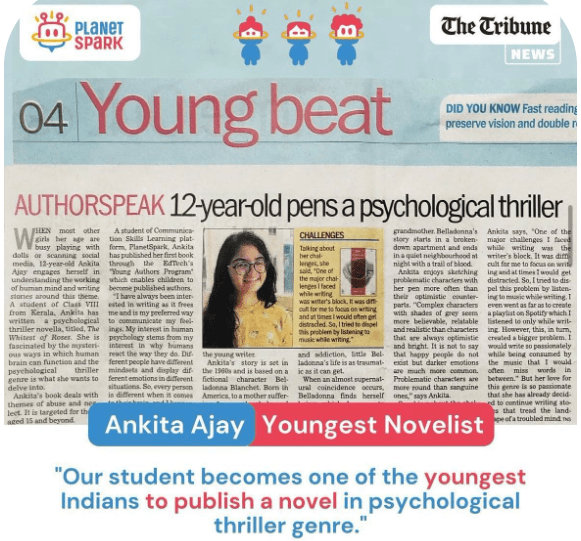Rainy Season Essay for Kids: Short & Long Examples

Table of Contents
Looking for a well-written rainy season essay for school exams or homework? This blog has 10-line, short, and long essays in simple language
Want your child to write better? Explore PlanetSpark’s 1:1 writing programs with personalised coaching and creative tools.
Rainy Season Essay (150–200 Words)
The rainy season is a beautiful time of the year that starts in June and continues till September in India. It brings cool winds, grey clouds, and lots of rainfall, providing relief after the hot summer months. The environment looks fresh and green during this season.
Children enjoy the rainy season by wearing raincoats, jumping in puddles, and making paper boats. At home, people like eating hot snacks like pakoras and drinking tea while watching the rain. Farmers are especially happy during this time because the rain helps them grow crops like rice, jute, and sugarcane.
However, the rainy season also causes some problems like traffic jams, floods, and mosquito-borne diseases. Despite these challenges, it is loved by everyone for its beauty and freshness. The sound of raindrops, the smell of wet soil, and the sight of blooming plants make this season truly special.

Good writing isn’t about big words, it’s about clear ideas. PlanetSpark helps your child express thoughts creatively and confidently. Book A Free Demo for Your Child Today!
Rainy Season Essay (400–500 Words)
The rainy season, also known as the monsoon, is one of the most awaited times of the year. In India, it generally begins in the month of June and lasts till September. After the dry and scorching summer, the rains bring comfort, greenery, and joy to everyone.
This season plays a very important role in Indian agriculture. Most farmers rely on monsoon rains to grow essential crops like rice, jute, sugarcane, and cotton. A good monsoon ensures a good harvest and supports the economy. In addition, it helps in maintaining water levels in rivers, ponds, lakes, and dams.
The beauty of the rainy season is unmatched. Trees and plants become greener, flowers bloom, and the smell of wet soil fills the air. The sight of children wearing colorful raincoats, playing with paper boats, and jumping in puddles brings smiles to everyone's faces. Rainy days at home are made cozy with hot food and warm drinks.
However, the rainy season also brings challenges. Waterlogging, traffic issues, power cuts, and increased mosquito breeding are common problems in cities. People must take precautions to stay healthy and avoid accidents.
In schools, this season is often the topic of art, writing, and speech competitions. It helps children explore nature and express their thoughts creatively.
In conclusion, the rainy season is both enjoyable and essential. It supports life, refreshes nature, and teaches us to appreciate the small joys that come with a change in weather.
Rainy Season Essay (800–1000 Words)
The rainy season, also called the monsoon, is a special time of the year that brings a wave of freshness, hope, and relief after the long summer. In India, the southwest monsoon usually arrives in June and continues till September. This season is not just about rain, it is about nature blooming, farmers smiling, and children celebrating every drop that falls from the sky.
Importance in Nature and Agriculture
The rainy season plays a major role in balancing the ecosystem. It refills water bodies like lakes, ponds, and rivers, which are crucial for drinking, farming, and electricity generation. Plants and trees regain their color and life. The dry, dusty air becomes cool and clean. This season is especially important in India, where a large part of the population depends on farming. Rainwater supports the cultivation of crops like rice, sugarcane, maize, and cotton. A good monsoon leads to food security and economic growth, while a weak one can cause droughts and hardships.
Daily Life and Joys of the Season
Children love the rainy season. It is a time to wear bright raincoats, jump in puddles, and float handmade paper boats. Families enjoy the season with hot pakoras, steaming tea, and warm conversations indoors. Many schools use this season as a theme for drawing contests, writing competitions, and rainy-day poetry. Rainy days are not just fun, but they also create moments of bonding and creativity.
Beauty of the Rainy Season
The visual beauty of the rainy season is striking. Grey skies, cool winds, and the rhythmic sound of rain create a calm and peaceful atmosphere. The smell of wet soil, known as petrichor, is refreshing. Trees and plants look cleaner and greener, and flowers bloom in bright colors. Rainbows occasionally appear after light showers, bringing joy to viewers.
Challenges and Disadvantages
Despite its many advantages, the rainy season comes with a few challenges. In urban areas, heavy rainfall leads to waterlogging, traffic jams, and potholes. Floods in rural areas can destroy homes, fields, and roads. Stagnant water becomes a breeding ground for mosquitoes, spreading diseases like dengue, malaria, and chikungunya. Lightning and storms can damage electrical lines and pose safety risks.
To deal with these problems, it is important to take precautions. Wearing proper rain gear, avoiding flood-prone areas, keeping the surroundings clean, and staying indoors during storms are some basic safety tips.
Conclusion
The rainy season is a gift of nature. It brings water to the thirsty land, food to the hungry, and joy to the hearts of children and adults alike. While we must be careful of the challenges it brings, we should also learn to appreciate its beauty and importance. Writing about this season helps students think deeply, describe clearly, and develop better writing habits.
Whether you're in Class 3 writing a short paragraph or in Class 8 preparing for a competition, the rainy season is a topic that encourages creativity, observation, and expression.
Rainy Season Essay 10 Lines
This version is best for young students and oral presentations.
The rainy season begins after summer and brings cool, fresh air.
It usually starts in June and continues till September in India.
The rain helps trees, plants, and crops grow well.
Children wear raincoats and play in puddles during rain.
Farmers depend on the monsoon to grow crops like rice and sugarcane.
Many people enjoy tea and hot snacks on rainy days.
Clouds fill the sky and rainbows appear after a shower.
Too much rain can cause waterlogging and diseases.
People use umbrellas and boots to stay dry.
I enjoy the rainy season because it makes nature look clean and green.
“Short essays build strong expression. At PlanetSpark, kids learn to write short and clear paragraphs with structure and creativity.”
Discover simple tips to boost your child’s creative writing skills.
Explore: 3 Tips on How to Get Started with Creative Essay Writing
Common School Assignments on This Topic
The rainy season is one of the most asked topics for essay writing in schools. Depending on grade level, students may be asked to write:
Rainy Season essay in English for Class 3
The Rainy Season essay for Class 5 in simple words
Essay on rainy season with 10 lines for Class 2
Paragraph writing about rainy days for Class 4 to 6
“Looking for ways to make your child’s writing stand out in class? PlanetSpark’s 1:1 coaching builds skill, speed and structure.”

How to Write a Rainy Season Essay – Step-by-Step Structure
Writing an essay becomes easy when children understand how to organise their thoughts. Here’s a simple structure your child can follow for writing about the rainy season:
1. Introduction
Begin with a sentence that sets the scene, when the rainy season starts (typically in June in India) and why it feels refreshing after the harsh summer. You can use a hook to make the reader feel the mood of the season.
Example: “After the long, hot summer, the first rain feels like a gift from nature.”
2. Body Paragraphs
Paragraph 1: The Beauty of the Season
Describe what makes the rainy season visually and emotionally appealing, the smell of wet soil, greenery everywhere, the sounds of rain and thunder, and the cloudy sky.Paragraph 2: Activities and Emotions
Include fun experiences like playing in puddles, making paper boats, wearing colorful raincoats, or enjoying hot snacks at home with family. Encourage children to write what they personally enjoy about the season.Paragraph 3: Rain and Its Benefits
Discuss the importance of the monsoon for farmers and how rainwater supports crops like rice and sugarcane. You can also mention how rain restores rivers, lakes, and groundwater.Paragraph 4: Challenges During the Rainy Season
It’s good to show a balanced view. Talk about problems like floods, traffic jams, mosquito breeding, and health issues. This teaches critical thinking while keeping the essay informative.
3. Conclusion
End the essay with a personal opinion or emotional reflection. Children can share why they love or dislike the season and what they learn from it.
Example: “Even though the rain causes some problems, it makes everything feel alive and new. That’s why it’s my favourite season.”
Looking for a writing formula that works for every topic, not just the rainy season?
Explore: 👉 Essay Writing for Kids – A Complete Guide
This guide helps your child learn how to write structured essays on any subject using proven tips, real examples, and age-appropriate techniques.
10 Interesting Facts About the Rainy Season
India’s rainy season is caused by southwest monsoon winds.
It begins in Kerala in early June and moves northwards.
The smell of the first rain on soil is called petrichor.
Rainbows often appear after a light shower with sunshine.
Rice and sugarcane are common monsoon crops.
Frogs become very active during monsoons.
Kids enjoy floating paper boats during rain.
In hilly areas, heavy rain can cause landslides.
Waterborne diseases increase in the rainy season.
The monsoon is celebrated in poems, songs and festivals across India.
“Writing about seasons builds real-life awareness and language clarity. PlanetSpark helps children sharpen these skills every day through structured writing practice.”
Improve Your Child’s Essay Writing with PlanetSpark
PlanetSpark offers more than just grammar lessons. We help children become confident communicators through personalised learning.
1:1 Personal Trainers
Every child learns with a certified trainer in a live, one-on-one class. The trainer understands your child’s learning style and pace.
Personalised Curriculum
We create a customised learning roadmap focused on improving grammar, vocabulary, fluency, writing structure and content flow.
SparkX – AI-Powered Feedback
Students record their essays or speeches. Our AI tool analyses voice clarity, sentence structure, delivery and confidence.
AI-Led Practice
Kids can practise narration and storytelling independently with instant AI feedback on fluency, grammar and pace.
Spark Diary
A digital writing journal helps children build consistency with fun daily writing prompts.
Gamified Learning
Learning becomes fun with Grammar Guru, Spell Knockout, Word Quizzes and more.
Parent-Teacher Meetings and Reports
Track your child’s improvement regularly with detailed progress reports and PTMs.
SparkShop and SparkBee
Explore digital grammar books, vocabulary boosters, and practice quizzes built for everyday learning.
“Want your child to write better essays, stories or speeches? Book a free creative writing trial with PlanetSpark today.”
FAQs – Rainy Season Essay
Q1. What is the best format for a rainy season essay?
Use a structure like: Introduction, Body (beauty, activities, importance, challenges), and Conclusion. Break it into 4 to 5 short paragraphs.
Q2. What is the ideal word length for Class 4 or 5 students?
For Class 4, aim for 100 to 150 words. For Class 5, a 200 to 300 word essay is appropriate.
Q3. How can students make their essays stand out?
Use real experiences, descriptive words, and clear language. Adding a personal opinion at the end also makes a difference.
Q4. Can this be used for speeches or elocution?
Yes. With slight changes in tone and delivery, the same content can be used as a school speech.
Q5. How does PlanetSpark improve essay writing skills?
PlanetSpark offers 1:1 personalised coaching, AI feedback tools, daily writing practice and fun learning modules that develop structure, vocabulary and creativity.
Master the art of essay writing, one season at a time - start with PlanetSpark’s personalised training.
Personalized Communication Report
Record a video to get a AI generated personalized communication report for your child

Hi There, want to try these
tips for your child with
LIVE with our expert coach?
Let's check your child's
English fluency
